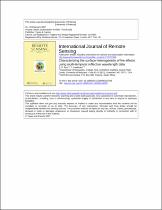 ResearchSpace
ResearchSpace
Characterizing the surface heterogeneity of fire effects using multi-temporal reflective wavelength data
JavaScript is disabled for your browser. Some features of this site may not work without it.
- ResearchSpace
- →
- Research Publications/Outputs
- →
- Journal Articles
- →
- View Item
| dc.contributor.author |
Roy, DP

|
en_US |
| dc.contributor.author |
Landmann, T

|
en_US |
| dc.date.accessioned | 2007-03-26T13:58:48Z | en_US |
| dc.date.accessioned | 2007-06-07T10:05:11Z | |
| dc.date.available | 2007-03-26T13:58:48Z | en_US |
| dc.date.available | 2007-06-07T10:05:11Z | |
| dc.date.copyright | en_US | |
| dc.date.issued | 2005-10-10 | en_US |
| dc.identifier.citation | Roy, DP and Landmann, T. 2005. Characterizing the surface heterogeneity of fire effects using multi-temporal reflective wavelength data. International Journal of Remote Sensing, vol. 26(19), pp 4197-4218 | en_US |
| dc.identifier.issn | 0143-1161 | en_US |
| dc.identifier.uri | http://hdl.handle.net/10204/2078 | en_US |
| dc.identifier.uri | http://hdl.handle.net/10204/2078 | |
| dc.description.abstract | The relationship between changes observed in multi-temporal remotely sensed data and disturbance processes are increasingly being studied in support of various land process modelling and management decision applications. The possibility of mapping both the location and degree of change and retrieving information concerning the disturbance process are primary goals. This paper studies changes in reflective wavelength data caused by the action of fire. We consider the heterogeneity of fire effects in terms of the fraction of the observation that burned (f) and the combustion completeness (cc). A spectral mixture model and field and satellite observations of prescribed fires are used to examine the relationship between change in reflectance, and cc and f. The prescribed fires were lit in different South African savannah types during the SAFARI 2000 dry season campaign. Implications for the development of methods to retrieve cc and f, for the development of methods to map the spatial extent of fire-affected areas with known detection capabilities are discussed. | en_US |
| dc.format.extent | 536013 bytes | en_US |
| dc.format.mimetype | application/pdf | en_US |
| dc.language.iso | en | en_US |
| dc.publisher | Taylor & Francis Ltd | en_US |
| dc.rights | Copyright: 2005 Taylor & Francis Ltd | en_US |
| dc.source | en_US | |
| dc.subject | Surface heterogeneity characteristics | en_US |
| dc.subject | Fire effects | en_US |
| dc.subject | Land process modelling | en_US |
| dc.subject | Management decision applications | en_US |
| dc.subject | Combustion completeness | en_US |
| dc.subject | Safari 2000 dry season campaign | en_US |
| dc.subject | Multi-temporal reflective wavelength data | en_US |
| dc.subject | Remote sensing | en_US |
| dc.subject | Imaging science | en_US |
| dc.subject | Photographic technology | en_US |
| dc.title | Characterizing the surface heterogeneity of fire effects using multi-temporal reflective wavelength data | en_US |
| dc.type | Article | en_US |
| dc.identifier.apacitation | Roy, D., & Landmann, T. (2005). Characterizing the surface heterogeneity of fire effects using multi-temporal reflective wavelength data. http://hdl.handle.net/10204/2078 | en_ZA |
| dc.identifier.chicagocitation | Roy, DP, and T Landmann "Characterizing the surface heterogeneity of fire effects using multi-temporal reflective wavelength data." (2005) http://hdl.handle.net/10204/2078 | en_ZA |
| dc.identifier.vancouvercitation | Roy D, Landmann T. Characterizing the surface heterogeneity of fire effects using multi-temporal reflective wavelength data. 2005; http://hdl.handle.net/10204/2078. | en_ZA |
| dc.identifier.ris | TY - Article AU - Roy, DP AU - Landmann, T AB - The relationship between changes observed in multi-temporal remotely sensed data and disturbance processes are increasingly being studied in support of various land process modelling and management decision applications. The possibility of mapping both the location and degree of change and retrieving information concerning the disturbance process are primary goals. This paper studies changes in reflective wavelength data caused by the action of fire. We consider the heterogeneity of fire effects in terms of the fraction of the observation that burned (f) and the combustion completeness (cc). A spectral mixture model and field and satellite observations of prescribed fires are used to examine the relationship between change in reflectance, and cc and f. The prescribed fires were lit in different South African savannah types during the SAFARI 2000 dry season campaign. Implications for the development of methods to retrieve cc and f, for the development of methods to map the spatial extent of fire-affected areas with known detection capabilities are discussed. DA - 2005-10-10 DB - ResearchSpace DP - CSIR KW - Surface heterogeneity characteristics KW - Fire effects KW - Land process modelling KW - Management decision applications KW - Combustion completeness KW - Safari 2000 dry season campaign KW - Multi-temporal reflective wavelength data KW - Remote sensing KW - Imaging science KW - Photographic technology LK - https://researchspace.csir.co.za PY - 2005 SM - 0143-1161 T1 - Characterizing the surface heterogeneity of fire effects using multi-temporal reflective wavelength data TI - Characterizing the surface heterogeneity of fire effects using multi-temporal reflective wavelength data UR - http://hdl.handle.net/10204/2078 ER - | en_ZA |





